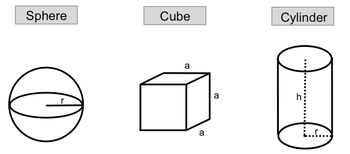Density is defined as the mass of an object divided by its volume, expressed mathematically as:
D = \frac{m}{V}
where D is density, m is mass, and V is volume. This concept can be applied to various geometric shapes, each with its own volume formula.
For a sphere, the volume can be calculated using the formula:
V = \frac{4}{3} \pi r^3
Here, r represents the radius, which is the distance from the center of the sphere to its surface. Understanding this formula allows you to determine the volume of a sphere when the radius is known.
In the case of a cube, where all sides are equal in length, the volume is given by:
V = a^3
In this formula, a denotes the length of one edge of the cube. This straightforward relationship highlights how the volume increases with the cube of the edge length.
For a cylinder, the volume is determined by both the radius and the height, expressed as:
V = \pi r^2 h
In this equation, r is the radius of the base of the cylinder, and h is the height. This formula illustrates how the volume of a cylinder is influenced by both its base area and its height.
By applying these volume formulas, you can solve density-related problems for spheres, cubes, and cylinders, allowing for a deeper understanding of how mass and volume interact in geometric contexts.












